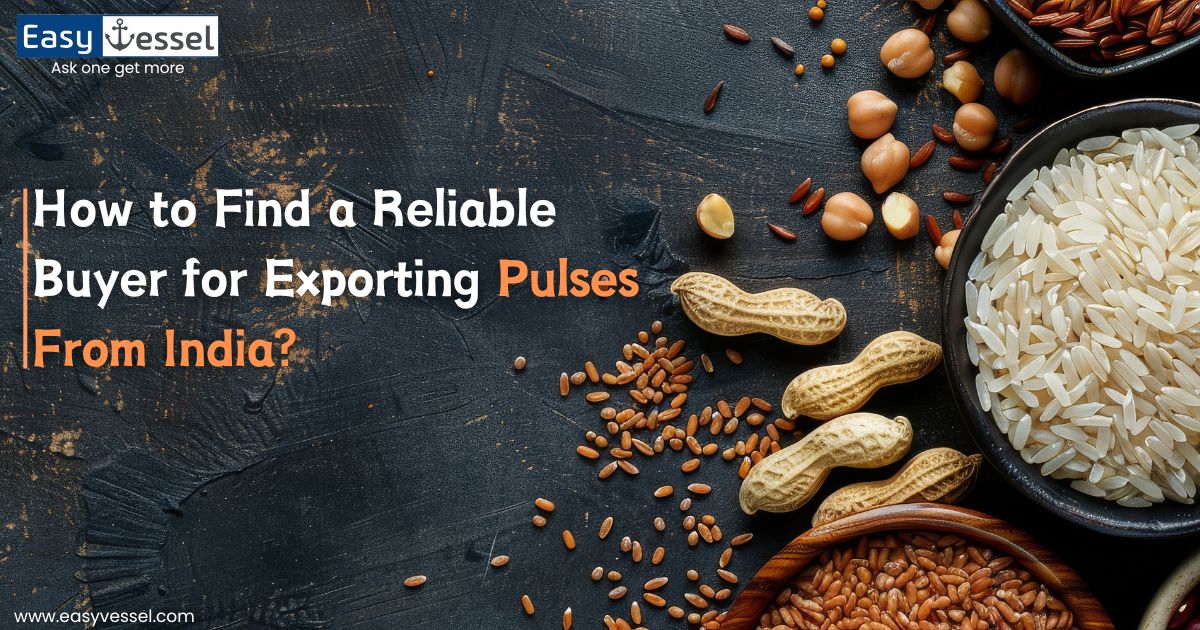- Exporting pulses from India can be a profitable venture, but finding reliable buyers is crucial to ensure smooth transactions and sustained business relationships.
- India imported 4.65 million metric tons of pulses in the fiscal year 2023-24, marking a six-year high.
- This import surge is attributed to lower domestic production and government policies aimed at controlling pulse prices.
Reasons for Importing Pulses:
Here are the 4 best reasons for importing pulses:
Meeting Consumption Needs: As highlighted by the National Statistical Office (NSO) study on “Household Consumer Expenditure,” the average consumption of pulses per person per month is significant, with rural areas consuming 0.737 kg and urban areas consuming 0.845 kg. To cater to this high consumption rate, imports are essential.
Diverse Preferences: India’s diverse population has varied dietary preferences that include different types of pulses such as lentils, chickpeas, and beans. Sometimes, domestic production may not be sufficient to meet the demand for specific varieties, leading to imports.
Price Stabilization: Importing pulses helps stabilize prices in the domestic market. When local production is insufficient, imports can prevent sharp price increases, ensuring pulses remain affordable for consumers.
Climate and Crop Failures: Variability in climate and unexpected crop failures can lead to shortfalls in pulse production. In such cases, imports are crucial to compensate for the reduced domestic yield.
Is India an importer of pulses?
- India, the world’s pulse powerhouse, also imports these lentils and chickpeas.
- This stems from a demand-supply imbalance.
- India’s growing population and rising health consciousness are driving up demand for pulses.
- However, weather variations can impact domestic production, necessitating imports to bridge the gap.
- While imports like the record 4.5 million tonnes in 2023-24 helped meet demand, they can lead to higher prices.
- To achieve self-sufficiency, the government is promoting domestic production through higher minimum support prices and encouraging agriculture in suitable regions.
What is the Demand and Supply of Pulses in India?
India is both a major consumer and producer of pulses, which play a crucial role in the country’s diet and agriculture. Here’s a detailed look at the demand and supply dynamics of pulses in India.
Demand:
Estimated Annual Demand: Studies by NITI Aayog and research institutions project a demand of 26-32 million metric tonnes (MT) of pulses by 2030-31. This growth is driven by factors like:
Population Rise: India’s burgeoning population translates to a constant increase in pulse consumption.
Dietary Shifts: Growing awareness of pulse’s nutritional benefits, particularly its high protein content, is driving demand.
Urbanization: Urban lifestyles often favor readily available dals and lentils.
Supply:
Production Fluctuations: India, despite being the world’s largest pulse producer (around 25% of global production), faces challenges in meeting demand. Factors influencing supply include:
Limited Land Availability: Pulse acreage competes with other crops, leading to production variations.
Rain Dependence: Most pulses are rain-fed, making them vulnerable to unpredictable weather patterns.
Yield Gap: Traditional farming practices and limited technology use can lead to lower yields compared to developed nations.
The Gap:
The persistent gap between demand and supply necessitates:
Imports: India relies on imports from countries like Canada and Myanmar to bridge the gap, with imports reaching 4.65 million MT in the 2023-24 fiscal year.
Bridging the Gap:
Efforts are underway to bridge the gap and achieve self-sufficiency:
Government Initiatives: Minimum support prices for pulses incentivize farmers to increase production.
Research and Development: Development of drought-resistant varieties and promotion of advanced farming techniques are key areas of focus.
Improved Infrastructure: Investments in storage and transportation infrastructure aim to minimize post-harvest losses.
Pulse Production in India
The overall production of pulses in India has been growing steadily. According to the Fourth Advance Estimates for 2020-21, the total production of pulses was expected to reach 25.72 million metric tons. This growth is driven by government initiatives, improved farming practices, and favorable weather conditions.
Consumption Patterns
Pulses are a staple in the Indian diet, providing essential protein and nutrients. According to the National Statistical Office (NSO) study on “Household Consumer Expenditure” conducted in the NSS 68th round, the average quantity of pulses and pulse products consumed per person in 30 days is:
Rural Areas: 0.737 kg
Urban Areas: 0.845 kg
These figures highlight the significant role pulses play in both rural and urban diets in India.
Projected Demand
The demand for pulses in India is expected to rise with the growing population and increasing health consciousness. The NITI Aayog Working Group study on “Demand and Supply Projections towards 2033 of Crops, Livestock, Fisheries, and Agricultural Inputs” projected that the demand for pulses would be around 26.05 million metric tons.
Seasonal Production Trends
India’s pulse production is divided into two main seasons: kharif (monsoon) and rabi (winter). Over the past five years:
Kharif Pulses: Accounted for approximately 36.5% of the total pulse production, with an average growth rate of 13%.
Rabi Pulses: Showed an average growth rate of 10.4%.
Which pulses are most consumed in India?
In Indian cuisine, a variety of pulses grace dinner tables, each with its own regional popularity and culinary uses. Here’s a rundown of the prominent pulses:
Chickpea (Chana): Known as the undisputed leader, Chana comes in two types: desi (smaller and earthier) and kabuli (larger and creamier). It’s a staple in dals, curries, and dishes like chana masala.
Pigeon Pea (Tur/Arhar): This versatile pulse is favored in soups, stews, and even pancakes, particularly popular in South India for its mild flavor and high protein content.
Moong (Green Gram): Moong dal is a light, easily digestible lentil enjoyed in soups, salads, and desserts like payasam. Its sprouted form is widely recognized as a health food.
Urad (Black Gram): Known for its distinctive black color and somewhat sweet flavor, urad dal is essential for making papad, idli batter, and adding depth to dals and sambar.
Summary: Regional preferences, cultural influences, and individual tastes contribute to the popularity of these pulses across India. One thing is certain: these humble legumes are indispensable in Indian cuisine, offering versatility, flavor, and essential nutrients.
Top Importing Countries for Pulses
Pulses are a vital part of diets worldwide, and several countries import them to meet their domestic demand. Here’s a detailed look at the top importing countries for pulses, highlighting their preferences and import statistics:
1. Canada:
- Canada is not only a significant exporter of pulses but also imports them to meet specific domestic needs and processing requirements.
- The primary pulses imported by Canada include chickpeas, lentils, and dry beans.
- Annually, Canada imports around 200,000 metric tons of pulses, with major sources being the United States, Turkey, and India.
- The driving factors for these imports include the diverse agricultural industry’s need for different varieties not widely grown domestically and the requirement for pulses in processing and re-export activities.
2. Myanmar
- Myanmar, while being a leading exporter of pulses, also imports certain types to complement its agricultural output and meet specific domestic demands.
- The main pulses imported by Myanmar are yellow peas and lentils.
- Each year, Myanmar imports approximately 50,000 metric tons of pulses, mainly from Canada and Australia.
- The imports are driven by the central role of pulses in the local diet and the need to cover shortfalls in specific varieties, thereby ensuring a stable food supply.
3. Tanzania
- Tanzania imports pulses to supplement its local production and ensure food security.
- The key pulses imported include lentils, chickpeas, and dry beans.
- Tanzania imports about 150,000 metric tons of pulses annually, primarily from neighboring countries and India.
- The increasing demand due to population growth and the need to stabilize the food supply amidst local production fluctuations are the main factors driving Tanzania’s pulse imports.
4. Kenya
- Kenya relies on pulse imports to meet the growing domestic demand and counterbalance limited local production.
- The primary pulses imported by Kenya are lentils, chickpeas, and pigeon peas. Each year, Kenya imports around 180,000 metric tons of pulses, mainly from Tanzania, Mozambique, and India.
- The integral role of pulses in the Kenyan diet and the agricultural challenges, such as climate variability affecting local production, drive the country’s pulse imports.
5. Bangladesh
- Bangladesh is a significant importer of pulses, driven by high domestic consumption and limited local production capacity.
- The main pulses imported include lentils, chickpeas, and mung beans.
- Annually, Bangladesh imports approximately 700,000 metric tons of pulses, with major suppliers being India, Australia, and Canada.
- The high population density, which increases food demand, and the crucial role of pulses in daily meals are the primary factors driving Bangladesh’s pulse imports.
Other Notable Importers
Bangladesh: Imports pulses to meet the demands of its growing population.
China: China has seen a surge in pulse imports driven by its growing population and rising health consciousness among consumers. China imports approximately 1-2 million metric tons of pulses annually.
Nepal: Relies on imports to supplement domestic production, especially for lentils.
Sri Lanka: Imports various pulses due to limited local production.
African Countries: Nations like Tanzania, Kenya, and Uganda import pulse to support their food security.
Factors Influencing Pulse Imports
Several factors influence the import of pulse in these countries:
Population Growth: Increased demand for food due to rising populations.
Dietary Preferences: Pulses are a staple in many traditional diets.
Domestic Production Shortfalls: Inadequate local production necessitates imports.
Government Policies: Trade policies and import regulations impact the volume of pulse imports.
Conclusion:
India, a major producer of pulses, imports to meet high demand and fluctuating domestic production, impacting prices. The government is working towards self-sufficiency by increasing minimum support prices and promoting cultivation in suitable regions. Easyvessel offers the lowest freight rates for pulse exports, which can be a profitable venture with the right market research, compliance, and logistics.
References:
Frequently Asked Questions
Finding genuine buyers for exports requires a strategic approach. Start with market research to identify potential buyers. Use trade directories, online marketplaces like easyvessel, and export promotion councils to find verified buyers. Participate in international trade fairs and leverage social media and networks like LinkedIn.
Exporting pulses from India involves obtaining an Importer Exporter Code (IEC) from DGFT, conducting market research, and ensuring compliance with importing countries’ regulations and standards. Register with APEDA for support, source high-quality pulse, and ensure proper packaging and labeling. Use online platforms, trade directories, and trade fairs to find buyers. Arrange logistics and customs clearance through reputable freight forwarders or platforms like Easyvessel.
India is the 3rd largest exporter of pulses globally, with significant exports to countries such as Bangladesh, China, UAE, USA, and Nepal. Exporters need an Importer Exporter Code (IEC) from DGFT and must comply with quality standards of importing countries.



